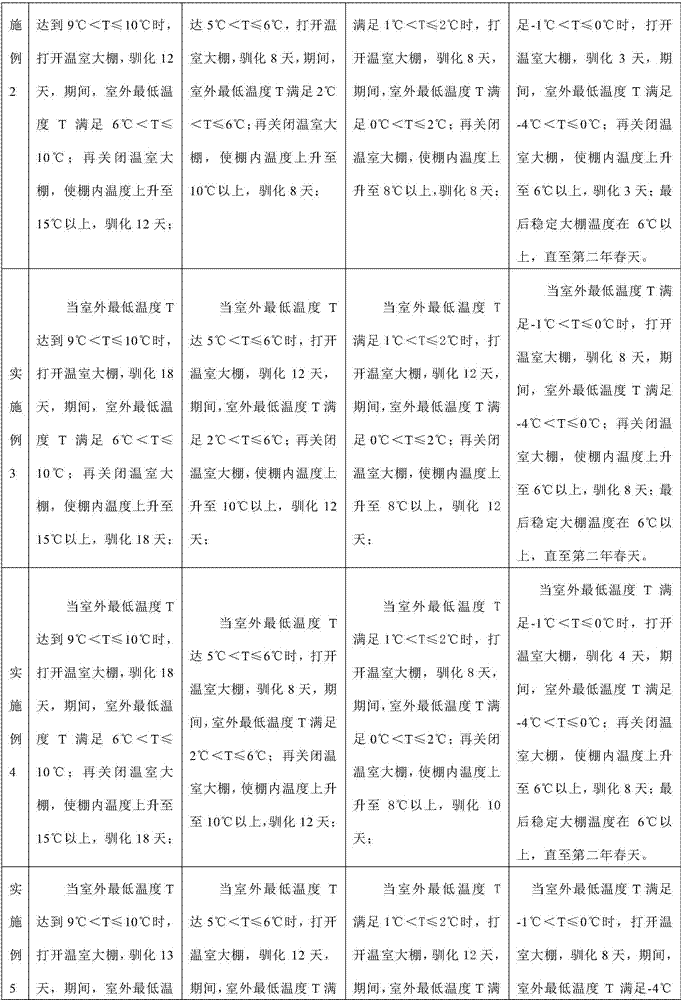Cold-resistant acclimation method for kandelia candel seedling pot plants planted at high latitude
A high-latitude, autumn eggplant technology is applied in the field of northward transplanting and domestication of mangrove plants and autumn eggplant seedlings potted cold-resistant domestication, which can solve the problems of difficult adaptation and low afforestation survival rate.
- Summary
- Abstract
- Description
- Claims
- Application Information
AI Technical Summary
Problems solved by technology
Method used
Image
Examples
Embodiment 1
[0044] (1) Seed selection: Candela seeds come from Fujian, and the collection time is from April to May every year. The first batch of precocious hypocotyls or eight or nine mature hypocotyls are collected, which have strong cold resistance and adaptability. Soak the seeds in local seawater for 1 hour and send them to the planting site as soon as possible (within 4 days). During the transportation of seedlings (that is, hypocotyls of candelabra), the tops of the seedlings are placed in the air-permeable bamboo baskets, and the bottom layer is placed with straw, which cannot be piled up, and ventilation is ensured.
[0045] (2) Placement of flowerpots: place flowerpots in the planting place, and then fill the flowerpots with planting soil; the diameter of the flowerpots used is 26cm, and the depth is 21cm; 50 meters away from the seawall, where the tide rises and falls, place 9 pots per square meter; the planting soil is a mixture of sea mud and sand, and the mass ratio of sea ...
Embodiment 2-5
[0061] Compared with Example 1, Example 2-5 is the same except that the temperature acclimation conditions in step (4) acclimatization are different; specifically, the specific steps of high and low temperature alternate acclimation cultivation in Example 2-5 are shown in Table 2 , T in Table 2 represents the minimum outdoor temperature, see Table 3 for acclimation test results.
[0062] Temperature acclimation condition in table 2 embodiment 2-5
[0063]
[0064]
[0065]
[0066] Acclimatization test result in table 3 embodiment 2-5
[0067]
Embodiment 6
[0069] In this example, except that the specific steps of alternating high and low temperature domestication and cultivation of candela hypocotyls transplanted in the planting place are different from those in Example 1, other steps are the same as in Example 1. The specific steps of high and low temperature alternate domestication and cultivation in this embodiment as follows:
[0070] The first stage of acclimation step: when the minimum outdoor temperature reaches 6°C, roll up the roller blinds for low-temperature acclimation for 10 days. During this period, the minimum outdoor temperature T should be higher than 2°C; Above 10°C, domesticate for 10 days;
[0071] The second stage of acclimation step: when the minimum outdoor temperature reaches 2°C, roll up the roller blinds for low-temperature acclimation for 10 days. During this period, the minimum outdoor temperature T should be higher than 0°C; Above 8°C, domesticate for 10 days;
[0072] The third stage of acclimatio...
PUM
| Property | Measurement | Unit |
|---|---|---|
| Caliber | aaaaa | aaaaa |
| Depth | aaaaa | aaaaa |
| Caliber | aaaaa | aaaaa |
Abstract
Description
Claims
Application Information
 Login to View More
Login to View More - R&D
- Intellectual Property
- Life Sciences
- Materials
- Tech Scout
- Unparalleled Data Quality
- Higher Quality Content
- 60% Fewer Hallucinations
Browse by: Latest US Patents, China's latest patents, Technical Efficacy Thesaurus, Application Domain, Technology Topic, Popular Technical Reports.
© 2025 PatSnap. All rights reserved.Legal|Privacy policy|Modern Slavery Act Transparency Statement|Sitemap|About US| Contact US: help@patsnap.com



